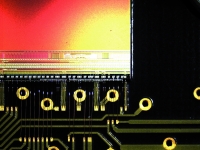 |
 |
|||||||||||||
|
|||||||||||||
|
|||||||||||||
|
Faster, higher, farther! The motto of this year's Olympic Games is also valid for the development of research opportunities. But unlike the Olympic athletes who struggle to beat world records by fractions of hundredths, the development of accelerator experiments is progressing in such extreme steps that researchers have to clear completely new hurdles – their measuring instruments are too inaccurate.
In particular, the researchers at the new photon sources are facing a problem: The future light sources like FLASH and the European XFEL are overstraining all the detectors normally used in this discipline. They are generating light flashes in such short intervals that the time resolution of the detectors and their electronics simply cannot cope with it. Moreover, their brightness is so extreme that they require detectors which are able to record both single photons and a billion of them. The requirements particle physicists put on their future detectors are not far from this: Precision detectors like the ones designed for the ILC do not only need a good time resolution, but also an extremely good position determination. Common problems unite. It is thus very convenient that the world’s elite of instrument and detector researchers will meet in October at the IEEE conference in Dresden. At a so-called satellite workshop to this world's largest conference on instrumentation, researchers from the fields of instrumentation, photon science and particle physics will meet at DESY on 16 and 17 October. The organisers expect 150 participants who will exchange ideas on requirements for new detectors and current possibilities of particle detection. This will provide the basis for joint research projects to successfully clear the hurdles of the next generation of research facilities. -- Thomas Zoufal, DESY
More info: |
|||||||||||||
| © International Linear Collider |
